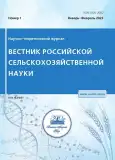Climate change and selection features of winter soft wheat on productivity and adaptability to it
- Авторлар: Grabovets A.I1, Fomenko M.A1
-
Мекемелер:
- Federal Rostov Agricultural Research Center
- Шығарылым: № 1 (2023)
- Беттер: 20-25
- Бөлім: Articles
- URL: https://journals.rcsi.science/2500-2082/article/view/144549
- DOI: https://doi.org/10.31857/2500-2082/2023/1/20-25
- EDN: https://elibrary.ru/OIFLKO
- ID: 144549
Дәйексөз келтіру
Толық мәтін
Аннотация
Негізгі сөздер
Авторлар туралы
A. Grabovets
Federal Rostov Agricultural Research Center
Email: grabovets_ai@mail.ru
M. Fomenko
Federal Rostov Agricultural Research Center
Әдебиет тізімі
- Айдаров А.Н., Шепелев С.С., Шаманин В.П. Характеристика по компонентам продуктивности высокостебельных и низкостебельных растений, выделенных из популяции крупнозернового пырея сизого (сорт Сова) в условиях южной лесостепи Западной Сибири // Вестник Омского государственного аграрного университета. 2021. № 3 (430). С. 5-16. https://doi.org/10.48136/2222-0364_2021_3_5
- Безуглая Т.С., Самофлова Н.Е., Иличкина Н.П. и др. Адаптивный потенциал новых сортов и линий твердой пшеницы в условиях Ростовской области // Зерновое хозяйство России. 2021. №3 (75). С. 27-33. https://doi.org/10.31367/2079-8725-2021-75-3-27-33.
- Грабовец А.И. Усовершенствованные методы оценки морозо- и зимостойкости растений // Селекция и семеноводство. 1983. № 2. С. 10-13.
- Лихенко И.Е. Современные проблемы селекции сельскохозяйственных культур в Сибири//Достижения науки и техники АПК. 2012. № 6. С. 19-20.
- Осипов Ю.Ф., Фадеева О.И., Федулов Ю.П. Рекомендации по разработке моделей сортов озимой пшеницы в зоне Северного Кавказа. В Сб.: Применение физиологических методов при оценке селекционного материала и моделировании новых сортов с. х. культур. М.; ВАСХНИЛ, 1983. С. 26-31.
- Ричардс Р.А., Кондон А.Г., Ребецке Г.Дж. Признаки, по которым улучшают урожайность в условиях засухи. В Сб: Применение физиологии в селекции пшеницы. Киев, Логос, 2007. С. 184-209.
- Романенко А.А., Беспалова Л.А., Котляров Д.В. Экономическая эффективность производства зерна на основе новых сортов озимой пшеницы селекции КННИСХ им. П.П. Лукьяненко // Достижения науки и техники АПК. 2016. № 3. С. 15-188.
- Самофлова Н.Е., Иличкина Н.П., Макарова Т.С. и др. Методы создания исходного материалы в селекции озимой твердой пшеницы и их результативность // Зерновое хозяйство России. 2020. № 2 (68). С. 54-60. https://doi.org/10.31367/2079-8725-2020-68-2-54-60
- Чем грозит человечеству потепление, и что делать для предотвращения катастрофы. ТАСС. Специальный проект (ревю). 2015. https://tass.ru/spec/climate.TASS. Special project (revue).
- Carter T.R., Jones R.N., Lu X.et al. Climate change 2007: impacts, adaptation and vulnerability, contribution of working group II to the fourth assessment report of the intergovernmental panel on climate change. Cambridge University Press, Cambridge, UK. 207. P. 133-171.
- Grabovets A.I., Fomenko M.A. Plus- transgression in winter wheat breeding on frost resistance and productivity. Russian Agricultural Sciences. 2019. № 45 (5). С. 407-411.
- Grabovets A.I., Fomenko M.A. Yield stability in a wide range of environments - the main parameter in winter wheat breeding / Russian Agricultural Science. 2020. Vol. 46. №5. P. 539-545. doi: 10.3103/S1068367420060075
- Hughey L. Biological consequences of global warming is the signal already apparent. Trends in Ecology & Evolution.1. 2000. Vol.15 (2). P. 56-61. DOI: 10.1016 / S0169-5347 (99) 01764-4
Қосымша файлдар









